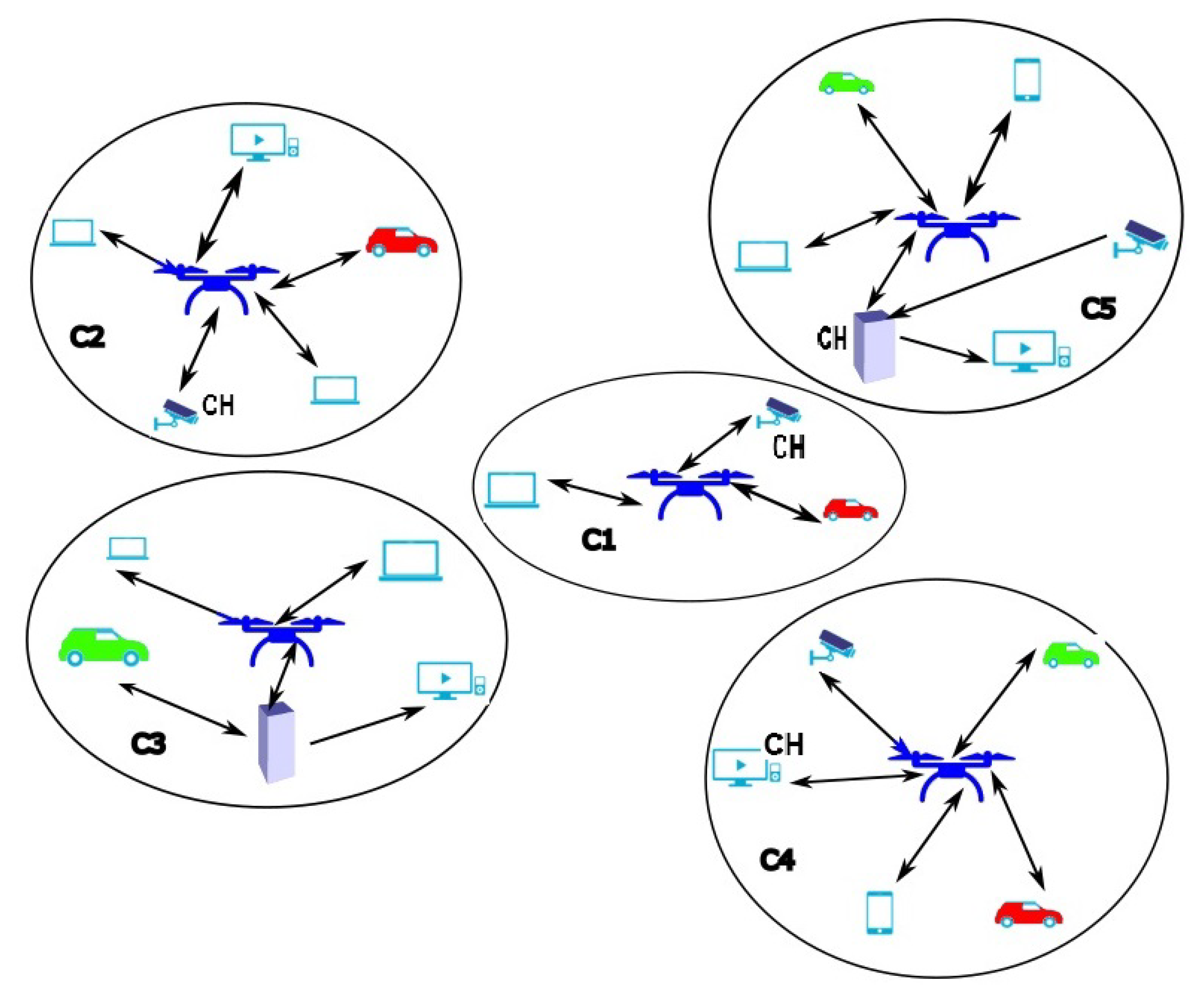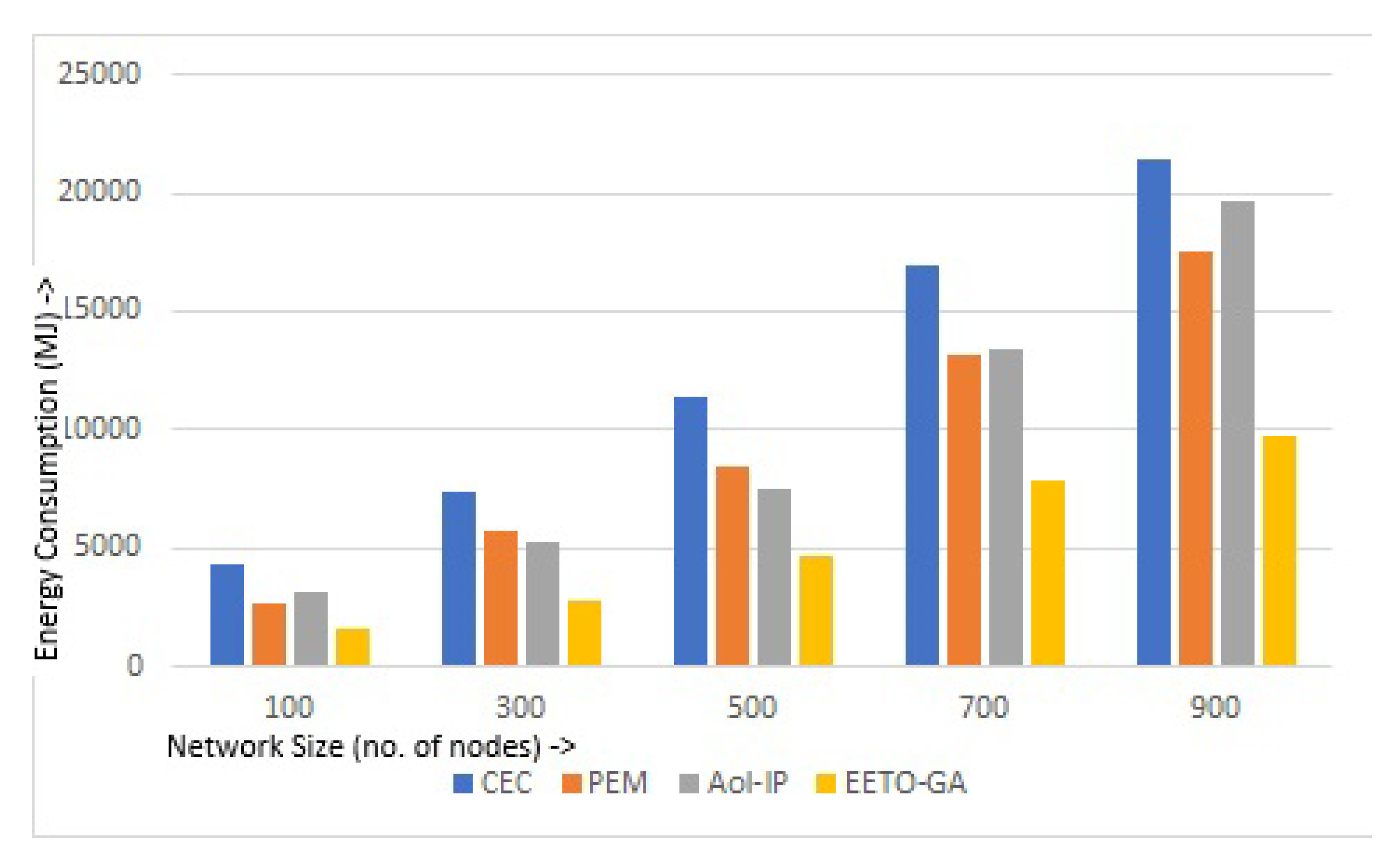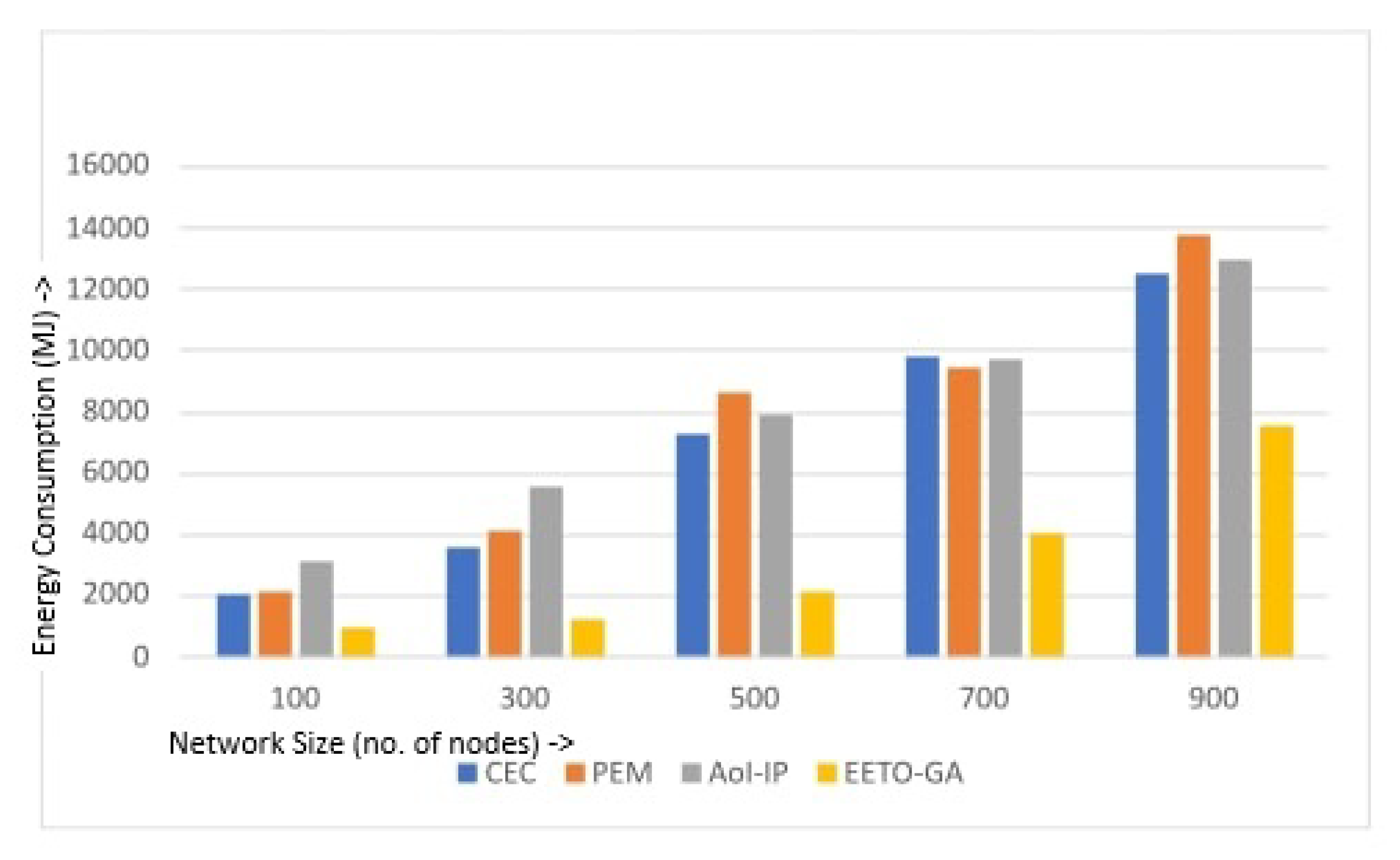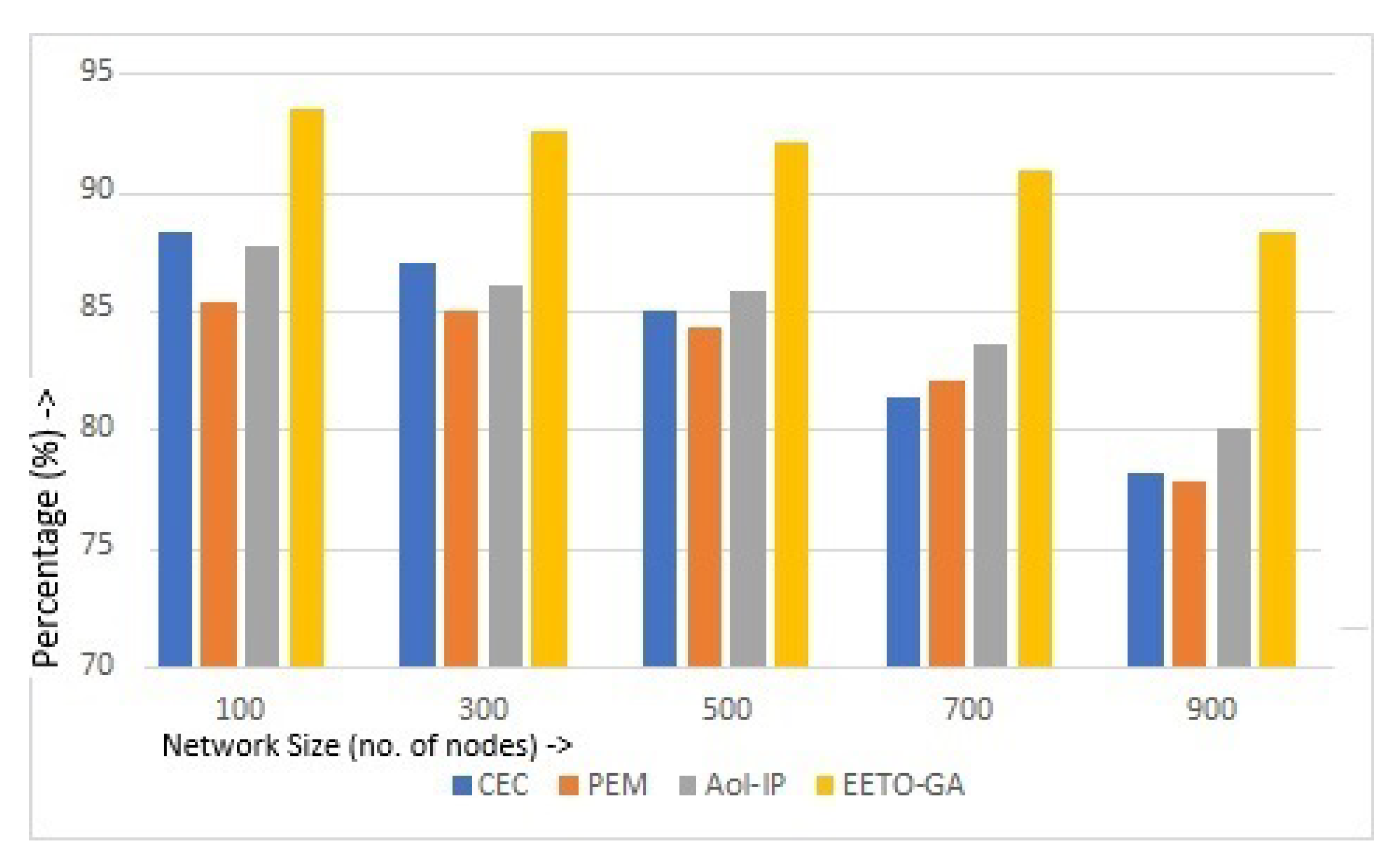EETO-GA: Energy Efficient Trajectory Optimization of UAV-IoT Collaborative System Using Genetic Algorithm
Abstract
1. Introduction
1.1. Highlights of this Article
- The IoT devices in our system are divided into multiple clusters with each cluster having a CH. A UAV flies over these CHs in such a trajectory that optimizes the number of tasks executed, the number of devices served, along with consumption of energy. Here we have avoided the round-robin mode of task execution because tasks are generally scheduled according to priority.
- Each CH maintains two tables, one corresponding to IoT devices under itself and the other corresponding to other CHs. Information about IoT devices is required to compute the priority of the current task submitted by one particular IoT device whereas cluster information is required to compute the credibility of the CH to be visited next. This trajectory planning of UAV is completely dynamic and with every traversal of CH, training data is refined with the most recent experiences(that is, made updated with the most recent records), so that the next CH to visit can be computed efficiently. Dynamic planning of energy-conserving UAV trajectory is an important contribution of this article.
- Energy is preserved not only during trajectory planning of UAVs but also during task propagation from a non-CH IoT device to its CH. When submitting the next task, this information is supplied to an IoT device by the CH so that its chance of being dropped becomes lower. This preserves the energy that would have been required otherwise for resubmitting the task. This is accomplished using the ARMA model [23] and decision tree [24].
- Use of GA enables incorporating a large number of clusters of IoT devices providing a scalability feature of the system.
- Simulation results demonstrate that our proposed scheme EETO-GA outperforms other state-of-the-art UAV trajectory optimization algorithms in terms of performance Metrics like UAV energy saved (UAVE), energy saving in IoT devices (IoTDEC), the average delay in execution of the task (ADET), and the percentage of tasks that could be completed (PTSK). Proposed EETO-GA improved average UAVE: 43%, IoTDEC: 56%, PTSK: 7.5%, and ADET: 38% over the state of the art.
1.2. Organization of the Article and Description of Used Symbols
2. Related Work
3. Proposed Method EETO-GA
3.1. Model Architecture
3.2. Selection of Clusterhead (CH)
3.3. Assigning Priority to Tasks
- i.
- —Unique identification number of the task.
- ii.
- —Unique identification number of the cluster member that has generated the task.
- iii.
- —Timestamp of generation of the task.
- iv.
- —Timestamp of completing execution of the task. If the task is not executed so far this field is set to −1. That is, for ongoing tasks, tm-exec is set to −1.
- v.
- —Priority assigned by the task.
- vi.
- —Length of the task.
- vii.
- —Starvation status of the task. An IoT device is termed as starving provided it was inserted at least three times in the task queue and subsequently got retrieved from it to give place to higher priority tasks.
Implementation Details of the Decision Tree
3.4. Prediction Next Timestamp of Task Submission
3.5. Traversal of UAV- on the Set of Clusterhead (CH)
- i.
- —This specifies the unique identification number of the CH whose task in the task queue has recently been executed by the UAV.
- ii.
- —Geographical latitude of the current CH is located by the UAV.
- iii.
- —Geographical longitude of the current CH is located by the UAV.
- iv.
- —Number of distinct IoT devices whose tasks have been executed by the UAV.
- v.
- —This specifies the number of tasks that were submitted.
- vi.
- —This specifies the number of tasks successfully completed.
- vii.
- —The amount of energy spent by the UAV in the execution of these tasks, is given by this attribute.
Details of Genetic Algorithm for Task Execution (GATE)
4. Simulation Experiments, Results, and Discussion
4.1. Simulation Environment
4.2. Formulation of Metrics and Results
4.3. Explanation
5. Conclusions and Future Scopes
Author Contributions
Funding
Institutional Review Board Statement
Informed Consent Statement
Data Availability Statement
Acknowledgments
Conflicts of Interest
References
- Mohsan, S.A.H.; Khan, M.A.; Noor, F.; Ullah, I.; Alsharif, M.H. Towards the unmanned aerial vehicles (UAVs): A comprehensive review. Drones 2022, 6, 147. [Google Scholar] [CrossRef]
- Liu, Y.; Dai, H.N.; Wang, Q.; Shukla, M.K.; Imran, M. Unmanned aerial vehicle for internet of everything: Opportunities and challenges. Comput. Commun. 2020, 155, 66–83. [Google Scholar] [CrossRef]
- Nazib, R.A.; Moh, S. Routing protocols for unmanned aerial vehicle-aided vehicular ad hoc networks: A survey. IEEE Access 2020, 8, 77535–77560. [Google Scholar] [CrossRef]
- Jia, Z.; Qin, X.; Wang, Z.; Liu, B. Age-based path planning and data acquisition in UAV-assisted IoT networks. In ICC Workshops, Proceedings of the 2019 IEEE International Conference on Communications Workshops, Shanghai, China, 20–24 May 2019; IEEE: New York, NY, USA, 2019; pp. 1–6. [Google Scholar]
- Maddikunta, P.K.R.; Hakak, S.; Alazab, M.; Bhattacharya, S.; Gadekallu, T.R.; Khan, W.Z.; Pham, Q.V. Unmanned aerial vehicles in smart agriculture: Applications, requirements, and challenges. IEEE Sensors J. 2021, 21, 17608–17619. [Google Scholar] [CrossRef]
- Hildmann, H.; Kovacs, E. Using unmanned aerial vehicles (UAVs) as mobile sensing platforms (MSPs) for disaster response, civil security and public safety. Drones 2019, 3, 59. [Google Scholar] [CrossRef]
- Kumar, N.; Puthal, D.; Theocharides, T.; Mohanty, S.P. Unmanned aerial vehicles in consumer applications: New applications in current and future smart environments. IEEE Consum. Electron. Mag. 2019, 8, 66–67. [Google Scholar] [CrossRef]
- Chaturvedi, S.K.; Sekhar, R.; Banerjee, S.; Kamal, H. Comparative review study of military and civilian unmanned aerial vehicles (UAVs). INCAS Bull. 2019, 11, 183–198. [Google Scholar] [CrossRef]
- Li, X.; Savkin, A.V. Networked unmanned aerial vehicles for surveillance and monitoring: A survey. Future Internet 2021, 13, 174. [Google Scholar] [CrossRef]
- Banerjee, A.; Sufian, A.; Paul, K.K.; Gupta, S.K. EDTP: Energy and Delay Optimized Trajectory Planning for UAV-IoT Environment. Comput. Netw. 2022, 202, 108623. [Google Scholar] [CrossRef]
- Li, B.; Na, Z.; Lin, B. UAV Trajectory Planning from a Comprehensive Energy Efficiency Perspective in Harsh Environments. IEEE Netw. 2022, 36, 62–68. [Google Scholar] [CrossRef]
- Aggarwal, S.; Kumar, N. Path planning techniques for unmanned aerial vehicles: A review, solutions, and challenges. Comput. Commun. 2020, 149, 270–299. [Google Scholar] [CrossRef]
- Zhang, H.; Xin, B.; Dou, L.h.; Chen, J.; Hirota, K. A review of cooperative path planning of an unmanned aerial vehicle group. Front. Inf. Technol. Electron. Eng. 2020, 21, 1671–1694. [Google Scholar] [CrossRef]
- Cabreira, T.M.; Brisolara, L.B.; Paulo R, F.J. Survey on coverage path planning with unmanned aerial vehicles. Drones 2019, 3, 4. [Google Scholar] [CrossRef]
- Goh, C.Y.; Leow, C.Y.; Nordin, R. Energy Efficiency of Unmanned Aerial Vehicle with Reconfigurable Intelligent Surfaces: A Comparative Study. Drones 2023, 7, 98. [Google Scholar] [CrossRef]
- Li, X.; Li, J.; Liu, D. Energy-Efficient UAV Trajectory Design with Information Freshness Constraint via Deep Reinforcement Learning. Mob. Inf. Syst. 2021, 2021, 1430512. [Google Scholar] [CrossRef]
- Debnath, S.K.; Omar, R.; Latip, N.B.A. A review on energy efficient path planning algorithms for unmanned air vehicles. In Proceedings of the Computational Science and Technology: 5th ICCST 2018, Kota Kinabalu, Malaysia, 29–30 August 2018; pp. 523–532. [Google Scholar]
- Zeng, Y.; Xu, J.; Zhang, R. Energy minimization for wireless communication with rotary-wing UAV. IEEE Trans. Wirel. Commun. 2019, 18, 2329–2345. [Google Scholar] [CrossRef]
- Dong, F.; Li, L.; Lu, Z.; Pan, Q.; Zheng, W. Energy-efficiency for fixed-wing UAV-enabled data collection and forwarding. In ICC Workshops, Proceedings of the 2019 IEEE International Conference on Communications Workshops, Shanghai, China, 20–24 May 2019; IEEE: New York, NY, USA, 2019; pp. 1–6. [Google Scholar]
- Johnson, D.B. A note on Dijkstra’s shortest path algorithm. JACM 1973, 20, 385–388. [Google Scholar] [CrossRef]
- Forrest, S. Genetic algorithms. ACM Comput. Surv. CSUR 1996, 28, 77–80. [Google Scholar] [CrossRef]
- Mirjalili, S. Genetic algorithm. In Evolutionary Algorithms and Neural Networks; Springer: Berlin/Heidelberg, Germany, 2019; pp. 43–55. [Google Scholar]
- Ljung, G.M.; Box, G.E. The likelihood function of stationary autoregressive-moving average models. Biometrika 1979, 66, 265–270. [Google Scholar] [CrossRef]
- Quinlan, J.R. Generating production rules from decision trees. In Proceedings of the IJCAI, Milan, Italy, 23–28 August 1987; Volume 87, pp. 304–307. [Google Scholar]
- Ueyama, J.; Freitas, H.; Faiçal, B.S.; Geraldo Filho, P.; Fini, P.; Pessin, G.; Gomes, P.H.; Villas, L.A. Exploiting the use of unmanned aerial vehicles to provide resilience in wireless sensor networks. IEEE Commun. Mag. 2014, 52, 81–87. [Google Scholar] [CrossRef]
- Arafat, M.Y.; Moh, S. A survey on cluster-based routing protocols for unmanned aerial vehicle networks. IEEE Access 2018, 7, 498–516. [Google Scholar] [CrossRef]
- Huang, S.; Teo, R.S.H.; Tan, K.K. Collision avoidance of multi unmanned aerial vehicles: A review. Annu. Rev. Control. 2019, 48, 147–164. [Google Scholar] [CrossRef]
- Yasin, J.N.; Mohamed, S.A.; Haghbayan, M.H.; Heikkonen, J.; Tenhunen, H.; Plosila, J. Unmanned aerial vehicles (uavs): Collision avoidance systems and approaches. IEEE Access 2020, 8, 105139–105155. [Google Scholar] [CrossRef]
- Wu, J.; Zou, L.; Zhao, L.; Al-Dubai, A.; Mackenzie, L.; Min, G. A multi-UAV clustering strategy for reducing insecure communication range. Comput. Netw. 2019, 158, 132–142. [Google Scholar] [CrossRef]
- Sun, Y.; Uysal-Biyikoglu, E.; Yates, R.D.; Koksal, C.E.; Shroff, N.B. Update or Wait: How to Keep Your Data Fresh. IEEE Trans. Inf. Theory 2017, 63, 7492–7508. [Google Scholar] [CrossRef]
- Talak, R.; Karaman, S.; Modiano, E. Optimizing information freshness in wireless networks under general interference constraints. In Proceedings of the Eighteenth ACM International Symposium on Mobile Ad Hoc Networking and Computing, Los Angeles, CA, USA, 26–29 June 2018; pp. 61–70. [Google Scholar]
- Zhang, L.; Celik, A.; Dang, S.; Shihada, B. Energy-efficient trajectory optimization for UAV-assisted IoT networks. IEEE Trans. Mob. Comput. 2021, 21, 4323–4337. [Google Scholar] [CrossRef]
- Qadir, Z.; Zafar, M.H.; Moosavi, S.K.R.; Le, K.N.; Mahmud, M.P. Autonomous UAV Path-Planning Optimization Using Metaheuristic Approach for Predisaster Assessment. IEEE Internet Things J. 2021, 9, 12505–12514. [Google Scholar] [CrossRef]
- Cui, J.; Ding, Z.; Deng, Y.; Nallanathan, A.; Hanzo, L. Adaptive UAV-trajectory optimization under quality of service constraints: A model-free solution. IEEE Access 2020, 8, 112253–112265. [Google Scholar] [CrossRef]
- Li, Y.; Zhang, H.; Long, K.; Jiang, C.; Guizani, M. Joint resource allocation and trajectory optimization with QoS in UAV-based NOMA wireless networks. IEEE Trans. Wirel. Commun. 2021, 20, 6343–6355. [Google Scholar] [CrossRef]






| Symbol/Abbreviation | Brief Description |
|---|---|
| X co-ordinate centroid of the cluster C. | |
| Y co-ordinate centroid of the cluster. | |
| Number of devices in cluster C. | |
| ith device of IoT devices. | |
| Denotes x latitude point of dev(i) location. | |
| Denotes y longitude point of dev(i) location. | |
| This function denotes Eligibility of the ith device dev(i) as head of its cluster. | |
| Residual energy of the ith device. | |
| Denotes new task. | |
| Possible priority of a new task submitted by the device dev(i) of cluster C. | |
| Information Gain. | |
| Computation priority. | |
| The entropy of the parent node. | |
| The average of entropies of all its children. | |
| Probability of the random selection of an element in class i. | |
| The maximum possible priority in the the system. | |
| The minimum priority of a task present in the task queue at current time t. | |
| Denotes multiple regression function. | |
| This function denotes increase the priority value. | |
| Timestamp of its generation based on current task . | |
| Timestamp of completing execution of the task . | |
| Length of the task where priority of the current task . | |
| A set of task submission sessions of dev(i) till current time . | |
| Currently computed priority. | |
| Percentage of task that could be completed. | |
| Average energy saving in IoT devices. | |
| UAV energy saved. | |
| Average delay in execution of the task. | |
| Unmanned aerial vehicles. | |
| Energy-Efficient Trajectory Optimization using Genetic Algorithm. | |
| Comprehensive energy consumption. | |
| ST ~ starve(i, t‘) | The subset of ST(i, t‘), which consists of only the nonstarving tasks. |
| The minimization of propulsion energy. | |
| Time Division Multiple Access. | |
| Predict the next suitable value. | |
| Generation of the next task of device I at current time . | |
| The CH closest to the UAV. | |
| Denotes the geographical position of the CHs in terms of latitude. | |
| Denotes the geographical position of the CHs in terms of longitude. | |
| Genetic algorithm applied for task execution. |
| Name of the Parameter | Value |
|---|---|
| max_depth (maximum number of levels permitted) | 8 (Selection based on all attributes is permitted) |
| min_samples_leap (minimum number if samples stable in a leap node) | 1 (least number of sample is 1) |
| min_sample_split (minimum number of samples a node must have before splitting) | 2 ( this is the minimum requirement in line with least number of samples per leaf is 1) |
| Name of the Parameter | Value |
|---|---|
| Coverage Area | 300 × 300 m2 |
| Number of IoT devices | 100, 300, 500, 700, 900 |
| Number of UAVs | 1, 3, 5, 7, 9 |
| Min no. of devices in a cluster | 3 |
| Max no. of devices in a cluster | 20 |
| Hovering altitude of UAV | 6 m |
| No. of CPU cycles/s in an UAV | 0.5G cycles/s |
| Channel gain | −20 dB |
| UAV speed | 20 m/s |
| Noise power | −50 dBm |
| Transmission bandwidth | 150 khz |
Disclaimer/Publisher’s Note: The statements, opinions and data contained in all publications are solely those of the individual author(s) and contributor(s) and not of MDPI and/or the editor(s). MDPI and/or the editor(s) disclaim responsibility for any injury to people or property resulting from any ideas, methods, instructions or products referred to in the content. |
© 2023 by the authors. Licensee MDPI, Basel, Switzerland. This article is an open access article distributed under the terms and conditions of the Creative Commons Attribution (CC BY) license (https://creativecommons.org/licenses/by/4.0/).
Share and Cite
Rahman, M.M.H.; Al-Naeem, M.; Banerjee, A.; Sufian, A. EETO-GA: Energy Efficient Trajectory Optimization of UAV-IoT Collaborative System Using Genetic Algorithm. Appl. Sci. 2023, 13, 2535. https://doi.org/10.3390/app13042535
Rahman MMH, Al-Naeem M, Banerjee A, Sufian A. EETO-GA: Energy Efficient Trajectory Optimization of UAV-IoT Collaborative System Using Genetic Algorithm. Applied Sciences. 2023; 13(4):2535. https://doi.org/10.3390/app13042535
Chicago/Turabian StyleRahman, M M Hafizur, Mohammed Al-Naeem, Anuradha Banerjee, and Abu Sufian. 2023. "EETO-GA: Energy Efficient Trajectory Optimization of UAV-IoT Collaborative System Using Genetic Algorithm" Applied Sciences 13, no. 4: 2535. https://doi.org/10.3390/app13042535
APA StyleRahman, M. M. H., Al-Naeem, M., Banerjee, A., & Sufian, A. (2023). EETO-GA: Energy Efficient Trajectory Optimization of UAV-IoT Collaborative System Using Genetic Algorithm. Applied Sciences, 13(4), 2535. https://doi.org/10.3390/app13042535






